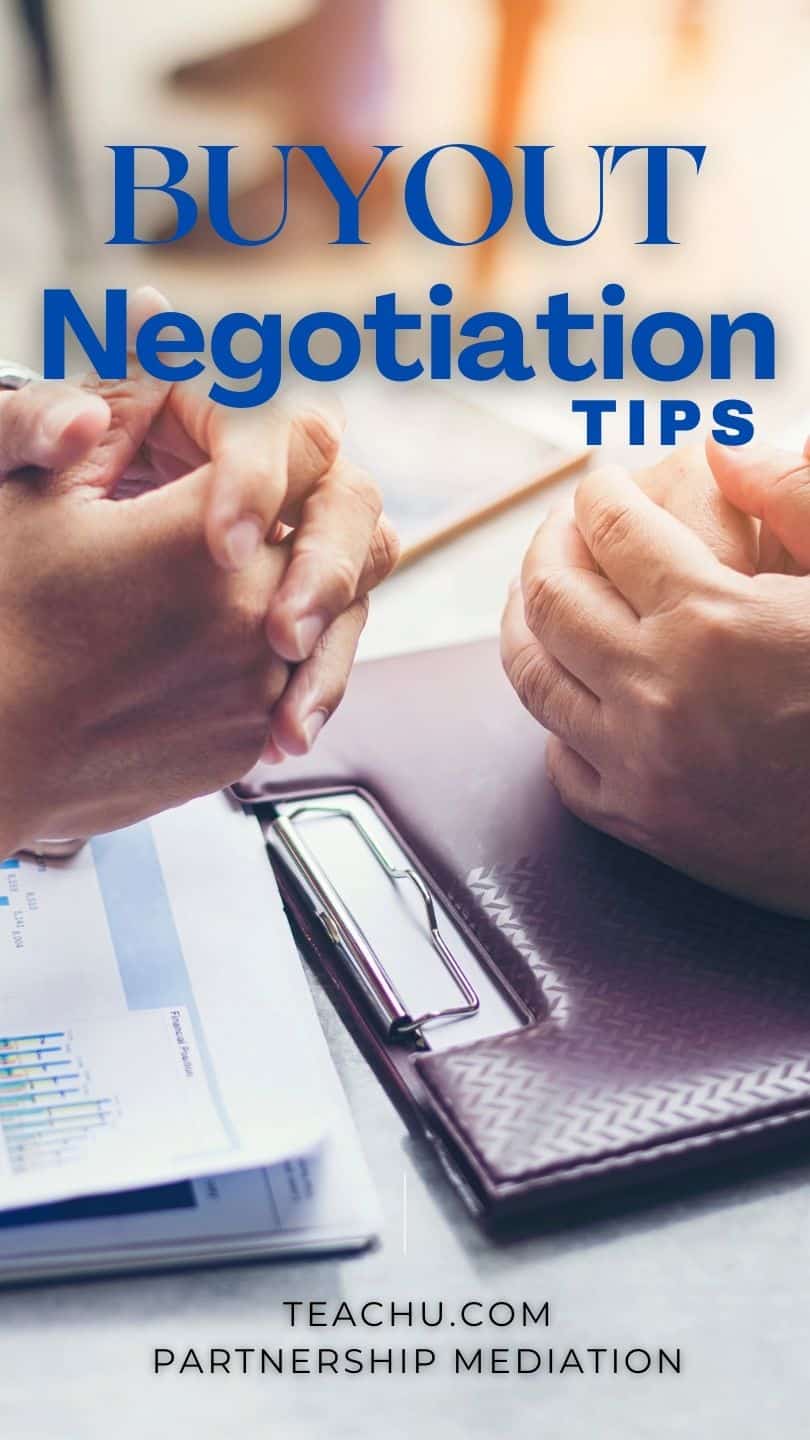Business Partnership Advisor
Together, we can fix your business and partnership problems

Chris Reich, Business Luminary
How to Determine the Value of Your Business
Email of the week:
Chris, I can no longer work with my business partner. It’s time to go our separate ways. How do we determine a fair value for the business so we can set up a buyout?
How to Determine the Value of a Business
There is much to consider when setting the value of a business. Talk with 100 experts and you’ll get 100 different valuations. None of those answers will be right because the true value of the business is determined by one thing: what a buyer will pay. The asking price is little more than a starting point in your negotiations with a potential buyer. Because of that, we’ll need to determine who our buyer is before we can set the price. Let me explain…
Rule #1 The Selling Price is Determined by What the Buyer Will Pay
As I said above, the price at which anything sells is determined by what a buyer is willing to pay. That doesn’t mean we cannot improve the buyer’s offer by providing more information, but ultimately whether the sale happens is up to the buyer.
If you want a valuation in order to buy your partner’s interest or to have your partner buy your stake, keep in mind that the sale price is probably going to be lower than a sale on the open market. If a partner is leaving because the partnership has problems, don’t expect to get the maximum value.
Remember, you have no right to get your price.
Rule #2 What You Put into the Business is Not Relevant
What you invested to start the business is called a ‘sunk cost.’ That cost was needed to get the doors open. For example, you might have put up the first month’s rent and a sizeable deposit. A buyer will not care. The buyer only sees what they get in exchange for what they pay.
If you and your best friend each put up $15,000 to buy a new car so you [both] can drive for Uber, you won’t get back $15,000 a year later if you decide you want out. The car has depreciated, and while driving for Uber is a good opportunity, you don’t build up a client base. The money you’ve made should more than cover the depreciation. But, if you can convince a buyer of the value of getting to drive a newish car without having to use their own, you might get a good price. Just don’t think you are entitled to get back what you put in.
Unless a business is successful, you cannot expect to recover sunk costs.
Rule #3 The Partnership Agreement Determines Much About the Sale
This should be the first rule but so few people have a Partnership Agreement that it’s a surprise to see one. When I walk people through what to include in a partnership agreement, we always discuss business valuation. If you have adopted a value or formula for calculating the value, you save a lot of grief and money if a buyout becomes necessary.
The Partnership Agreement should specify the rules for selling a partner’s share. Sometimes, the agreement prohibits a partner from selling.
“The value of anything to be sold is determined by what a buyer is willing to pay.” Chris Reich, Business Mediator
Image from Pixabay
Method 1: Are We Making Any Money?
This method is good for a service business like a marketing firm or some other mostly service business. It’s an easy formula and a good starting point to find a sale value for any business.
We start with the financial statements. We need to determine the net profit for the past 2 1/2 years. If the owners are taking a salary and deducting their draws from net, add whatever the owners have taken back in. That gives an accurate picture of net profit. We want 2 1/2 years of net. I’ll tell you what to do if the business is less than 2 1/2 years old. For now, let’s say the 2 1/2 year net profit is $310,000.
Next, let’s look at the value of real assets. These are the items a buyer would need to keep the business going. For example, if we have a widget polishing business, and we use a commercial widget polisher, that machine needs to be included in our estimated value of the business.
If we bought that machine for $70,000 and now it’s 4 years old, it might be worth $40,000 today. Think about it this way. If I wanted to find a good used machine, what would I have to pay? Let’s use $40,000.
Are there other things necessary for the business? Tools? Other machines? Supplies? Let’s say that we agree that there are about $500 worth of supplies.
Notice that I do not include office furniture, computers, telephones, etc. We might decide to include something for those items later. But too often owners add $3,000 in furniture, but all they are selling is a 7 year old computer and a banged-up metal desk. The new owner will probably prefer new stuff.
Can we assume there is life left on the lease? Will the landlord allow a transfer of the lease? Unless there is a 20 year lease at a super bargain rate, we won’t need to include a premium.
Also, we won’t need to figure in the payables or receivables. If they are at normal levels, we’ll assume they will wash out in the profit calculation we made. If the payables are higher than normal because you just financed $15,000 to repair the widget polisher, we might need to pay attention unless that expense will be covered before the sale is finalized.
Thus, 2 1/2 Year’s net: $310,000 Plus our machinery: $40,000 Plus Adjustments: $0
We’ve found a value of $350,000. That’s a decent place to start. If the business has some inventory—not junk, real saleable goods, add the value of your inventory. (Note: if the inventory is not paid for, don’t add it!)
Selling to your partner? Start with $350,000 / 2 = $175,000 But realize that selling to a partner during a time of tension isn’t going to command the best price.
Method 2 Look at Profit, Assets, Growth, and Goodwill
This is good for larger sized businesses, including services, product sales, manufacturing. We still want to see 2-3 years of net profit and we include the value of the real assets. We also might use the past year to plot a trend. If the business is growing rapidly, we will use 2-3 years of profit X 1.X X is the growth rate. That means if we are growing at 36% per year, we’ll use 2 1/2 years of net profit X 1.36. Using these figures, our net is $350,000. Multiply by 1.36 = $476,000
To the $476,000 we’ll add the other items we discussed: machines, equipment, supplies. If you sell a product, we can add the value of your inventory. Only add the inventory if it’s paid for. Why? If I’m selling you a car dealership with 500 cars on the lot worth 500 X $39,000 (average value) = $19,500,000! Yes, I get those cars but I still have to pay the automaker for them. Paying you and the automaker means I pay double. Inventory only has value to a buyer if it’s paid for.
You’ll have to do some serious selling to command this price so be ready to support your numbers.
Method 3 Let’s Count Everything
If the business is more substantial, producing big revenue, we’ll need to look at everything. Once we’ve made a calculation, we go up or down as we think we can. Some businesses are at the edge of rapid growth. Tesla Motors would be a good example. The company has spent billions to set up manufacturing and sales networks. Musk has built a respected brand. And, the electric car is gaining popularity. If your business is proven with growing revenue and shrinking operating costs, we have far more latitude with pricing.
Start by looking at 1 year’s sales. That’s a lot higher number than net. If sales are growing at a fast rate, we can assume there will be big profits soon. Amazon grew sales rather than profit for many years before hitting huge returns.
Consider how long it will take a buyer to pay off the business from net profit. I like 5 years if the situation is right. Even if the business had no net profit last year because we expanded or paid cash for new equipment, we can estimate a 5 year pay back. That’s a pretty attractive option for many buyers. To that, we need to consider the difference between what we owe and what is owed us. If we owe a couple thousand dollars and have a million dollars in receivables, we need to add something to our 5 year net starting point.
Receivables are paid for. The sales happened and the goods shipped or the work was performed. I’d consider adding about 50 cents on the dollar for the receivables. Why? You could close the business today and collect those receivables without doing any further work. That’s free money to the buyer.
Add the values of your equipment and supplies. Add the value of your inventory or finished goods. Add the value of the domain name (tools.com is worth a lot more than ChrisHasAToolBusiness.biz) Add the value of the website itself (Can you imagine recreating Amazon’s site???!).
Now we should consider the value of our lease. If we have a great deal on our location and the landlord will allow the new owner to have the same terms for 20 years more, that’s a great asset. Finally, there is Goodwill. If the business (not you) has a super-loyal following, add something for that. It’s hard to build a reputation!
Finally, we need to consider any serious liabilities and liquid assets. Is there a big lawsuit pending from an ex-employee? Is there a million dollars in cash sitting in the bank? Take these items into consideration.
This is obviously the most complicated method and it takes some deep diving in the books to reach a fair value using this approach.
Never Forget Rule #1
Even after all of this, the final price will be determined by the buyer. If you used a method, the buyer will be more open to your price. You can, after all, justify what you are asking for by demonstrating the method you used.
Finally, consider the buyer. If it’s your partner, you’ll have to prepare yourself to accept less.
Few outside parties want to buy into a business with a partner you want to escape! The best return will come from selling the entire business.
Need Guidance? I Will Help You
It took most of a day to write this. It must be overwhelming to read it! If you need help evaluating your business or negotiating a buyout with your partner, I can help you. If you want to sell your business, I can help with the right method of valuation. And we can create an attractive package for potential buyers.
Chris Reich, Business Partnership Mediator
“There are many methods to calculate the value of a business, but ultimately, the buyer determines the true value.”
Do you like FREE services? Contact me now for a 100% confidential and 100% FREE consultation.





